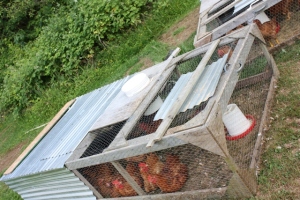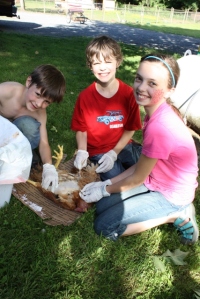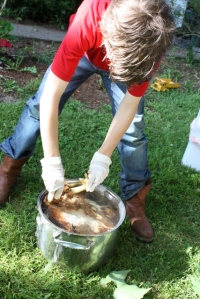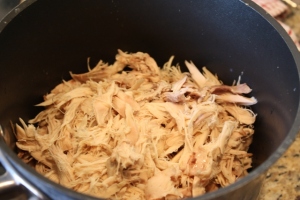When I think about my cherished upbringing in the suburbs, I still sometimes do a double take as I’m walking outside each morning to milk a goat and feed 80 chickens and such. Whose life is this?! Mine. Only mine. And though it brings with it all sorts of interesting challenges, I wouldn’t trade any of it. Starting with the six amazing children we’ve been blessed with and straight on down to the poor attempt at a garden outside my kitchen window. I thought perhaps it might be helpful/interesting to get a step by step snapshot of our “let’s grown our own clean, well-treated chickens” endeavor. So, if it is, read on…otherwise check in later this week for updated baby goat photos or scroll straight to the bottom for photos of our kids butchering their first chicken!
- First off, we decided last year that if we ever planned to raise our own food for meat, we’d better taste something comparable to make sure we liked it. If you’ve eaten grass fed beef alongside feedlot cattle from the grocery store, you can certainly tell the difference and we figured chicken would be similar. Those frozen disks of ginormous chicken breast are pumped with salt and other stuff and the taste is a long ways from a pastured chicken fed only good things. I’d guess the nutrition varies a good deal between the two as well. We purchased three large broilers (code for “raw whole chicken”…its okay, I didn’t know that either) last year from a local farmer. This darling young couple runs a small farm near us and offers a weekly CSA produce basket as well as various animals for meat (goats, chickens, turkeys, pigs and I think a cow or two). They weighed about 6 1/2 pounds and cost us about $30 each. I know, sticker shock, I can get 13 pounds of frozen breasts at Costco for that price! The meat was incredible, buttery rich and tender and delicious. The chickens were so large they would feed even our family for two meals which is quite something. We were sold and looked forward to trying to do this ourselves the coming spring.
- There are two paths to choose on raising your own chickens for meat, you buy Cornish Cross type chicks that are commercially bred to produce huge breasts and grow super fast. They are ready to process (code for “butcher your chicken so you can eat it”) in about 6 weeks. Its wild, really. Tiny chick to big chicken ready for your table in a month and a half. But that breed is behind our American obsession with white meat and cheap (less than healthy) food. We figured if we were going to all this trouble, we might as well go the heritage breed route and raise the traditional, slower growing, normally proportioned sort of poultry. We chose Freedom Ranger chicks from a hatchery in Pennsylvania run by an Amish family. With a name like “Freedom Rangers” they were hard to pass up, and more importantly this was the breed our farmer Micha had grown so we knew they were tasty.
- Perhaps step #3 should be “start small”. But we don’t do small very well and wanted it to be worth the work, so we went big, hoping to grow in 12 weeks or so, enough chicken to last our family many months. We purchased 54 chicks that arrived March 20 to our local post office. We also figured we’d lose some, but at this point, just 10 days from processing day, there are 51 of them out there in the yard!
- They need to eat! A ton. Literally. Well almost. We will have purchased about 1000 lbs of feed for them by the time they are ready. Finding a good price for quality feed was imperative. There are a few local mills that offer bulk pricing, we first used Scratch and Peck in Bellingham but then when that ran out (so much for my careful calculations!) we bought from Natural Farm and Feed east of the mountains. Both were bulk orders brought by truck on pallets. But after comparing the two, we’ll go with Natural Farm and Feed for next year. Better price and less waste from the feed. Buying feed that was non-GMO, didn’t contain corn or soy, was important. Again, why go to the trouble to raise meat yourself only to feed it “junk food”? That is why we chose a whole grain, non-GMO, soy/corn free feed to grow the birds. It wasn’t cheap, it was hundreds of dollars spent at one time for only a hope of translating into healthy, wonderful food for our family.
- They need a safe, predator-proof place to live. A friend of a friend sold us two movable chicken tractors that our birds live in. We move them every day but they still trash the grass worse than you can imagine in their 24 hours on each fresh patch!

- They need massive amounts of water. Because these birds grow so fast (in comparison to their egg laying counterparts) they eat, drink, poop at a much higher rate. It’s amazing. Using 5 gallon buckets with chicken nipples plugged into holes on the bottom is my absolute easiest, cleanest, favorite method of watering chickens. I made 4 of them this year and couldn’t be more pleased with how they’re working. The bucket rests upside down in the tractor so I can fill it from the top without opening their pen. Lovely, because they are aggressive and always HUNGRY! They love to peck my farm boots or any fingers that are available.

- Well, that’s all I’ve got so far….we’ve rented the processing equipment for a week from Saturday from our county. Once we complete this adventure, I’ll post again with any other tidbits from along the way! For now, here are pics of our kids hand-processing a chicken two days ago (I was in a hurry and clipped his wing while moving the chicken tractor before church!). They were very eager to help turn this bird into dinner. We enjoyed chicken gravy and mashed potatoes tonight, courtesy of one happy, healthy bird that lived its whole life in our yard. Pretty super cool if you ask me…





Baby likes chicken dinner!!!

Love that your kids are so enthusiastic about processing chickens!! You guys are doing a great job. 🙂
Can’t wait to see what you all learn on butchering day. It is bound to be eventful! Things always are at your house…(<: